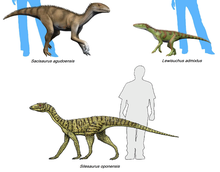| Silesaurids Temporal range: ?Middle Triassic – Late Triassic, ?
| |
|---|---|

| |
| Scientific classification | |
| Domain: | Eukaryota |
| Kingdom: | Animalia |
| Phylum: | Chordata |
| Clade: | Ornithodira |
| Clade: | Dinosauromorpha |
| Clade: | Dinosauriformes |
| Clade: | Dracohors |
| Clade: | Dinosauria |
| Clade: | †Ornithischia (?) |
| Family: | †Silesauridae Langer et al., 2010 |
| Subgroups | |
| |
Silesauridae is an extinct family of Triassic dinosauriforms. It is most commonly considered to be a clade of non-dinosaur dinosauriforms, and the sister group of dinosaurs.[1][2][3][4][5] Some studies have instead suggested that most or all silesaurids comprised an early diverging clade or a paraphyletic grade within ornithischian dinosaurs.[6][7][8][9] Silesaurids have a consistent general body plan, with a fairly long neck and legs and possibly quadrupedal habits, but most silesaurids are heavily fragmentary nonetheless. Furthermore, they occupied a variety of ecological niches, with early silesaurids (such as Lewisuchus)[10] being carnivorous and later taxa (such as Kwanasaurus)[11] having adaptations for specialized herbivory. As indicated by the contents of referred coprolites, Silesaurus may have been insectivorous, feeding selectively on small beetles and other arthropods.[12]
- ^ Nesbitt, S.J.; Sidor, C.A.; Irmis, R.B.; Angielczyk, K.D.; Smith, R.M.H.; Tsuji, L.M.A. (2010). "Ecologically distinct dinosaurian sister group shows early diversification of Ornithodira". Nature. 464 (7285): 95–98. Bibcode:2010Natur.464...95N. doi:10.1038/nature08718. PMID 20203608. S2CID 4344048.
- ^ Nesbitt, S.J. (2011). "The early evolution of archosaurs: relationships and the origin of major clades". Bulletin of the American Museum of Natural History. 352: 1–292. doi:10.1206/352.1. hdl:2246/6112. S2CID 83493714.
- ^ Cite error: The named reference
Kammereretal2012was invoked but never defined (see the help page). - ^ Cite error: The named reference
Ornithoscelidawas invoked but never defined (see the help page). - ^ Andrea Cau (2018). "The assembly of the avian body plan: a 160-million-year long process" (PDF). Bollettino della Società Paleontologica Italiana. 57 (1): 1–25. doi:10.4435/BSPI.2018.01 (inactive 20 November 2024).
{{cite journal}}: CS1 maint: DOI inactive as of November 2024 (link)[dead link] - ^ Ferigolo, Jorge; Langer, Max C. (1 January 2007). "A Late Triassic dinosauriform from south Brazil and the origin of the ornithischian predentary bone". Historical Biology. 19 (1): 23–33. doi:10.1080/08912960600845767. ISSN 0891-2963. S2CID 85819339.
- ^ Langer, Max C.; Ferigolo, Jorge (1 January 2013). "The Late Triassic dinosauromorph Sacisaurus agudoensis (Caturrita Formation; Rio Grande do Sul, Brazil): anatomy and affinities". Geological Society, London, Special Publications. 379 (1): 353–392. Bibcode:2013GSLSP.379..353L. doi:10.1144/SP379.16. ISSN 0305-8719. S2CID 131414332.
- ^ Cabreira, S.F.; Kellner, A.W.A.; Dias-da-Silva, S.; da Silva, L.R.; Bronzati, M.; de Almeida Marsola, J.C.; Müller, R.T.; de Souza Bittencourt, J.; Batista, B.J.; Raugust, T.; Carrilho, R.; Brodt, A.; Langer, M.C. (2016). "A Unique Late Triassic Dinosauromorph Assemblage Reveals Dinosaur Ancestral Anatomy and Diet". Current Biology. 26 (22): 3090–3095. doi:10.1016/j.cub.2016.09.040. PMID 27839975.
- ^ Müller, Rodrigo Temp; Garcia, Maurício Silva (26 August 2020). "A paraphyletic 'Silesauridae' as an alternative hypothesis for the initial radiation of ornithischian dinosaurs". Biology Letters. 16 (8): 20200417. doi:10.1098/rsbl.2020.0417. PMC 7480155. PMID 32842895.
- ^ Ezcurra, Martín D.; Nesbitt, Sterling J.; Fiorelli, Lucas E.; Desojo, Julia B. (24 August 2019). "New specimen sheds light on the anatomy and taxonomy of the early Late Triassic dinosauriforms from the Chañares Formation, NW Argentina". The Anatomical Record. 303 (5): 1393–1438. doi:10.1002/ar.24243. hdl:11336/129047. ISSN 1932-8494. PMID 31444989.
- ^ Martz, Jeffrey W.; Small, Bryan J. (3 September 2019). "Non-dinosaurian dinosauromorphs from the Chinle Formation (Upper Triassic) of the Eagle Basin, northern Colorado: Dromomeron romeri (Lagerpetidae) and a new taxon, Kwanasaurus williamparkeri (Silesauridae)". PeerJ. 7: e7551. doi:10.7717/peerj.7551. ISSN 2167-8359. PMC 6730537. PMID 31534843.
- ^ Martin Qvarnström; Joel Vikberg Wernström; Rafał Piechowski; Mateusz Tałanda; Per E. Ahlberg; Grzegorz Niedźwiedzki (2019). "Beetle-bearing coprolites possibly reveal the diet of a Late Triassic dinosauriform". Royal Society Open Science. 6 (3): Article ID 181042. Bibcode:2019RSOS....681042Q. doi:10.1098/rsos.181042. PMC 6458417. PMID 31031991.